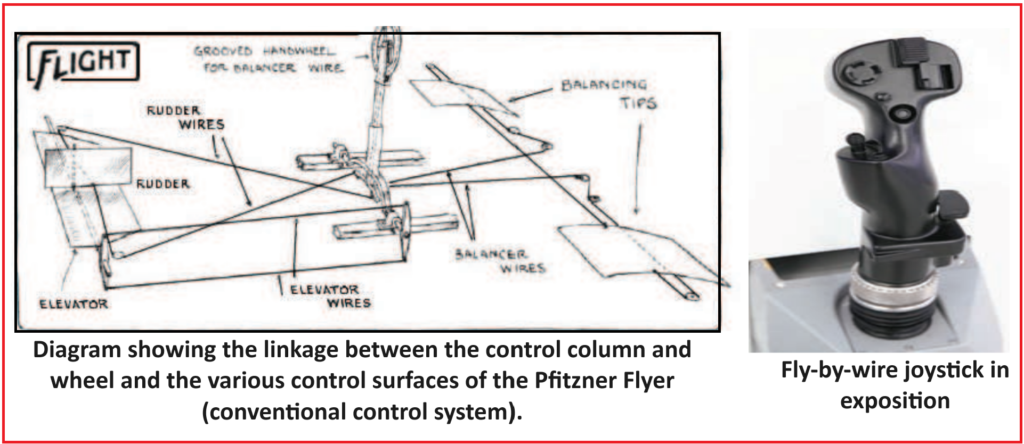Fly by wire (FBW) is an advanced flight control system technology that replaces traditional manual flight controls with electronic interfaces. Instead of mechanical linkages, FBW systems use electrical signals to transmit pilot commands to control surfaces, such as ailerons, elevators, and rudder.
What is Fly By Wire Control System?
Fly by wire (FBW) is a revolutionary flight control system technology that replaces traditional manual flight controls with electronic interfaces. Instead of mechanical linkages, Fly by wire systems utilize electronic signals transmitted by wires to convey the pilot’s inputs to the control surfaces. Flight control computers then interpret these signals and determine the appropriate movements of the actuators at each control surface to achieve the desired aircraft response.
One of the significant advantages of Fly by wire systems is their ability to enable automatic functions without direct pilot input. Flight control computers can autonomously stabilize the aircraft or perform other functions to enhance safety and efficiency. This automation capability contributes to smoother flight operations and can assist pilots in managing challenging flight conditions.

Compared to traditional mechanical and hydro-mechanical flight control systems, Fly by wire systems offer several key benefits. They are lighter in weight since they eliminate the need for bulky mechanical linkages and hydraulic components. Additionally, Fly by wire systems provide greater flexibility in aircraft design and routing of control signals. They can also offer improved compensation for changing aerodynamic conditions, enhancing aircraft performance and maneuverability.
Despite these advantages, it’s important to note that Fly by wire systems are not immune to potential failures or adverse aircraft characteristics such as stalling or spinning. However, the incorporation of redundant backup systems and advanced control algorithms helps mitigate these risks and ensures continued safe operation of the aircraft.
While the term “Fly by wire” originally referred to purely electrically-signaled control systems, it has evolved to encompass a broader concept of computer-configured controls. In modern aviation, fly-by-wire systems involve the integration of sophisticated computer systems that mediate between the pilot’s inputs and the final control actuators or surfaces. This intermediary role allows for precise control parameter adjustments and enhances overall flight control capabilities.
How Fly by wire System Works?
Fly by wire systems revolutionize aircraft control by replacing traditional mechanical linkages with electronic interfaces. When a pilot manipulates the control column, electrical signals are transmitted to a central flight control computer through multiple wires or channels. This computer processes the signals and sends commands to actuators associated with control surfaces, dictating their movements. Feedback from sensors in the actuators allows the computer to ensure precise control surface positioning, with the system adjusting until the desired position is achieved, at which point signals cancel out, halting actuator movement. This feedback loop enables responsive and accurate control of the aircraft’s flight dynamics based on the pilot’s inputs, enhancing safety and maneuverability.
The fly-by-wire system’s operation is streamlined yet sophisticated, embodying a seamless interaction between pilot inputs, computer processing, and actuator response. By translating pilot commands into precise control surface movements through electronic signals, fly-by-wire systems offer enhanced reliability, responsiveness, and adaptability compared to traditional mechanical systems. This advanced technology enables modern aircraft to maintain stable flight conditions, respond effectively to varying aerodynamic conditions, and mitigate potential risks, ushering in a new era of aviation safety and performance.
Automatic Stability Systems
Automatic stability systems, enabled by fly-by-wire control systems, autonomously stabilize aircraft without direct pilot intervention. These systems utilize gyroscopes equipped with sensors mounted within the aircraft to detect changes in pitch, roll, and yaw axes. Upon sensing any deviation from nominal conditions, the gyroscopes transmit signals to the aircraft’s computer. Subsequently, the computer automatically adjusts control actuators to counteract the detected movement and restore stability to the aircraft. By continuously monitoring and responding to changes in flight dynamics, automatic stability systems enhance flight safety and mitigate the effects of turbulence or other disturbances, contributing to smoother and more stable flight experiences.
Digital Fly By Wire
A digital fly-by-wire flight control system operates similarly to its analog counterpart but utilizes digital computers for signal processing, allowing pilots to essentially “fly-via-computer.” This digital technology enhances the flexibility of the flight control system by enabling computers to receive input from various aircraft sensors, such as altimeters and pitot tubes. Additionally, digital systems offer increased electronic stability as they are less reliant on critical electrical components found in analog controllers.
In a digital fly by wire system, computers receive inputs from pilot controls and aircraft sensors, processing this data to determine appropriate command signals. By solving differential equations, the computers calculate precise control inputs required to execute the pilot’s intentions. Notably, the Airbus A320 marked a milestone in aviation history by becoming the first airliner to fly with an all-digital fly-by-wire control system, showcasing the advancements and benefits of digital technology in modern aircraft control systems.
Fly-By-Wire Advantages
Fly-by-wire systems offer several key advantages:
- Weight Reduction: By replacing traditional mechanical linkages with electronic interfaces, fly-by-wire systems significantly reduce aircraft weight. This weight reduction translates into fuel savings, contributing to improved fuel efficiency and reduced operating costs.
- Streamlined Maintenance: Fly-by-wire systems simplify maintenance procedures by eliminating the need for manual adjustments. Instead, faulty components can be quickly replaced with new ones, reducing maintenance downtime and increasing aircraft availability.
- Enhanced Stability: Fly-by-wire systems provide improved response to air gusts and turbulence, enhancing passenger comfort during flight. The electronic control of aircraft movements allows for smoother and more stable flight experiences, minimizing discomfort caused by sudden changes in aircraft attitude.
- Automatic Control: Fly by wire systems offer automatic control of maneuvers, mitigating the risk of pilot-induced errors or excessive force exertion on the controls. By autonomously adjusting control surfaces to maintain stability, these systems enhance flight safety and reduce pilot workload, particularly during challenging flight conditions or emergencies.